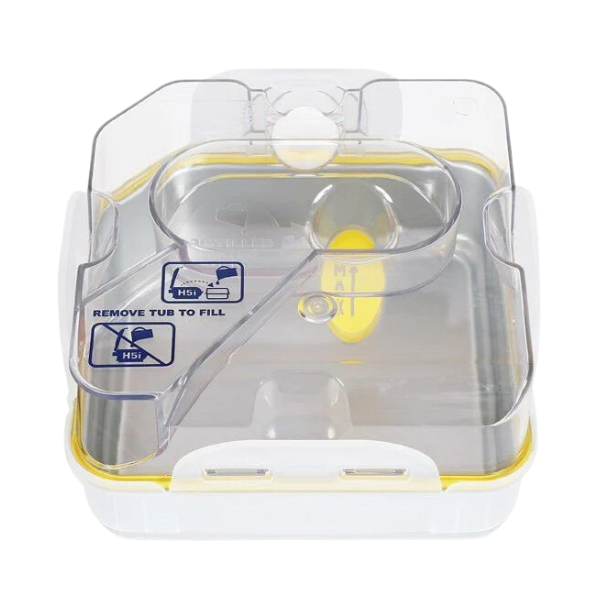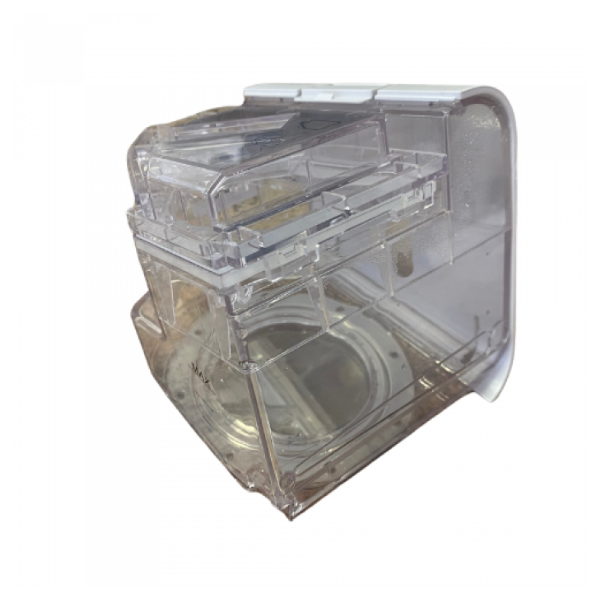 Universal Inline Heat Moisture Exchange CPAP Humidifier FilterSpecial Price $4.95 Regular Price $5.95
Universal Inline Heat Moisture Exchange CPAP Humidifier FilterSpecial Price $4.95 Regular Price $5.95
CPAP Machine Humidification: CPAP Humidifiers and Water Chambers
The air coming through your CPAP (Continuous Positive Airway Pressure) machine requires humidification, because as it enters your upper airway the increased airflow can cause your nasal airway to lose warmth and humidity.
CPAP humidifiers are designed to replace the moisture in your airways that is lost during CPAP therapy, helping to prevent sore throat, dry mouth, irritation in your nasal passages or nosebleeds, and damaging the soft tissues of your upper airway and lungs.
CPAP water chambers are designed to retain the water that the CPAP machine humidifier utilizes to create humidity. Some humidifier water chambers are designed to work in conjunction with heated humidifiers. Distilled water should always be used in your water chamber, instead of tap water.
Types of CPAP Humidifiers and Water Chambers
CPAP humidification systems vary across all types of different sleep apnea therapy machines, like CPAPs, BiPAPs, and Travel CPAP machines. Most use a form of heated water humidification, whereas some travel CPAP machines, for example, utilize waterless humidification. Here are some of the most common types of CPAP humidifiers and water chambers:
Types of CPAP Humidifiers
-
Integrated Humidifiers: Integrated or or built-in humidifiers are permanently attached or connected to the CPAP machine and cannot be removed, although the water chamber can be removed separately for cleaning and replacement. Typically offer a compact design, are easy to setup, and typically have adjustable settings for various humidity levels. These types of humidifiers are usually only compatible with the CPAP machine they're built into.
-
Standalone Humidifiers: Separate units that can be utilized with different, compatible CPAP machines, as they have their own power cord and short hose to connect to various CPAP devices. They often offer advanced features and a larger capacity for water.
-
Heated Humidifiers: A heated CPAP humidifier is a water chamber that typically uses a hot plate to heat the distilled water, so that the dry air is moisturized going through your CPAP tubing to your CPAP mask during CPAP therapy. Heated CPAP humidifiers are most suitable for those who are experiencing dryness during sleep apnea treatment and for those in cooler, less humid environments.
-
Passover Humidifiers: Passover humidification allows air to pass over room temperature distilled water that is inside your water chamber chamber, causing the air to pick up moisture as it’s carried through your CPAP tube to your CPAP face mask and airway. Typically passover humidifiers provide lower pressure delivery and generally deliver cold air — but you can utilize a heated tube, which promotes heated humidification and can also help to prevent rainout and condensation buildup.
-
Adaptive Humidifiers: Adaptive CPAP humidifiers automatically adjust the humidity level based on various environmental conditions, which helps to ensure optimal comfort and performance.
Types of CPAP Water Chambers
-
Standard Water Chambers: Basic CPAP water chambers are designed to hold distilled water for CPAP humidification, and are typically made of plastic. Most standard CPAP water chambers are not dishwasher-safe, unless otherwise stated by the manufacturer.
-
Heated Water Chambers: Heated CPAP water chambers are designed for use with heated humidifiers, are often insulated to promote heat retention and maintain consistent, optimal humidity levels. Typically they feature a heated plate beneath the water chamber to heat the distilled water.
-
Dishwasher-Safe Water Chambers: Designed using dishwasher-safe materials that can withstand intense heat and heavier detergents, making cleaning and maintenance much easier.
-
Autofill Water Chambers: Autofill humidifier chambers are designed to automatically replenish distilled water from a pole bag in order to maintain water levels by continuously refilling your water chamber. They typically incorporate a dual-float mechanism.
Shop our selection of CPAP humidifier water chambers and heated hoses and tubing.
-
How to Clean CPAP Humidifier Water Chambers
Regularly cleaning your CPAP water chamber is crucial to maintaining optimal performance and hygiene, and prolonging the lifespan of your CPAP humidifier water chamber.
Daily Cleaning
-
Empty any excess water leftover in your CPAP machine water chamber.
-
Wash your water chamber with warm water and a mild soap or detergent.
-
Rinse your water chamber thoroughly with warm, running water, making sure all excess soap and residue is removed.
-
Allow your water chamber to air dry in a well-ventilated area, out of direct sunlight, and away from excessive heat.
Weekly Cleaning
-
Empty any excess water leftover in your CPAP machine’s water chamber.
-
Wash your water chamber with warm water and a mild soap or detergent and allow it to soak for about 15-30 minutes.
-
Fully submerge your water chamber in a solution of one part white vinegar to three parts water and allow it to soak for about 10-30 minutes. This step helps disinfect and remove any mineral buildup in your CPAP water chamber.
-
Thoroughly rinse your water chamber under running, warm water, making sure all excess vinegar, soap and residue is removed.
-
Allow your CPAP water chamber to air dry completely in a well-ventilated location, away from direct sunlight and excessive heat.
Make sure you refer to the manufacturer’s user manual that is included with your CPAP device before deciding which cleaning solution to use, or if it is recommended to use products such as vinegar, or a dishwasher to clean your equipment.
Browse our selection of CPAP cleaning supplies and read more about cleaning your CPAP supplies with this helpful blog.
-
How Often to Replace CPAP Humidifier Water Chambers
CPAP machine humidifier water chambers can have varying lifespans that differ based on many factors such as how well your water chamber is maintained, how often you use your CPAP machine and humidifier, and the quality of your water chamber. Generally CPAP humidifier water chambers last an average of 6 months and it is typically recommended to replace your water chamber at that time.
Learn more about the ideal replacement schedule for your CPAP supplies with this helpful blog.
Side Effects
Consulting your healthcare provider for medical advice before deciding which CPAP humidification system to use, as not all equipment works the same for every CPAP user. Cleaning and maintaining your CPAP humidifier water chamber is not only essentially to ensuring optimal sleep apnea treatment effectiveness and comfort, but it also helps prevent many serious side effects, such as:
-
Bacterial and Mold Growth
-
Odor
-
Mineral Buildup
-
Decreased Humidification
-
Compromised Equipment Lifespan
-
Allergic Reactions
-
Respiratory and Sinus Inflammation, Irritation and Infections
-
Exacerbation of Sleep Apnea Symptoms
-













